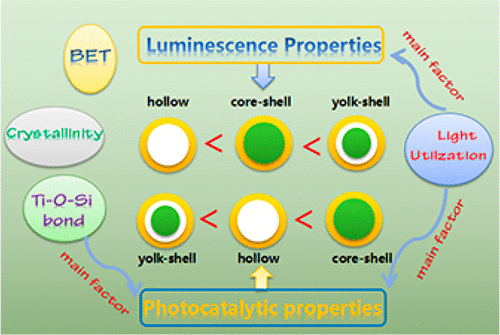当前位置:
X-MOL 学术
›
ACS Sustain. Chem. Eng.
›
论文详情
Our official English website, www.x-mol.net, welcomes your
feedback! (Note: you will need to create a separate account there.)
Photocatalytic and Photoluminescence Properties of Core–Shell SiO2@TiO2:Eu3+,Sm3+ and Its Etching Products
ACS Sustainable Chemistry & Engineering ( IF 7.1 ) Pub Date : 2017-11-16 00:00:00 , DOI: 10.1021/acssuschemeng.7b02285 Meiqi Chang 1 , Yanhua Song 1 , Jie Chen 1 , Lei Cui 1 , Zhan Shi 2 , Ye Sheng 1 , Haifeng Zou 1
ACS Sustainable Chemistry & Engineering ( IF 7.1 ) Pub Date : 2017-11-16 00:00:00 , DOI: 10.1021/acssuschemeng.7b02285 Meiqi Chang 1 , Yanhua Song 1 , Jie Chen 1 , Lei Cui 1 , Zhan Shi 2 , Ye Sheng 1 , Haifeng Zou 1
Affiliation

|
A novel multifunctional core–shell, yolk–shell SiO2@TiO2:Eu3+/Sm3+ and hollow TiO2:Eu3+/Sm3+ structures were successfully synthesized. The relationship between morphology/ions doping and multifunctional properties including photoluminescence and photocatalysis has been discussed in detail for the first time using systematic characterization techniques, including scanning electron microscopy (SEM), transmission electron microscopy (TEM), X-ray diffraction (XRD), photoluminescence (PL), ultraviolet–visible light (UV-vis) analysis, Fourier transform infrared (FT-IR) spectroscopy, Brunauer–Emmett–Teller (BET) surface area analysis, and X-ray photoelectron spectroscopy (XPS). Upon ultraviolet (UV) excitation, the products show the characteristic red and orange–red emission lines of Eu3+ and Sm3+, respectively. In addition, Judd–Ofelt intensity parameters (Ω2, Ω4) were used to investigate the symmetry and coordination state of Eu3+ ions in the products with different morphologies. The relative luminescence intensities were in the following order: yolk–shell > core–shell > hollow structure. This phenomenon can be ascribed to the unique yolk–shell configuration, which possesses appropriate interior cavity used for multiple reflections and scattering, allowing for more-efficient utilization of the light. Moreover, compared with yolk–shell and hollow structure, the core–shell spheres exhibit excellent photoactivity for the degradation of MO, because the existence of Ti–O–Si bonds increases the surface acidity of the sample, thereby activating the oxidation reaction. In addition, the electron activation in the TiO2 matrix can be facilitated through intermediate oxygen atoms. Moreover, products doped with different rare-earth (RE3+) ions exhibited distinguishable photocatalytic performance. The surfactant-free method provides a promising route toward the development of multifunctional materials for many applications in photocatalysis and PL.
中文翻译:

核壳SiO 2 @TiO 2:Eu 3+,Sm 3+及其刻蚀产物的光催化和光致发光性质
新型多功能核-壳,蛋黄-壳SiO 2 @TiO 2:Eu 3+ / Sm 3+和中空TiO 2:Eu 3+ / Sm 3+结构已成功合成。首次使用系统表征技术,包括扫描电子显微镜(SEM),透射电子显微镜(TEM),X射线衍射(XRD),详细讨论了形态/离子掺杂与多功能特性(包括光致发光和光催化)之间的关系。 ,光致发光(PL),紫外-可见光(UV-vis)分析,傅立叶变换红外(FT-IR)光谱,Brunauer-Emmett-Teller(BET)表面积分析和X射线光电子能谱(XPS)。在紫外线(UV)激发下,产物分别显示出Eu 3+和Sm 3+的特征性红色和橘红色发射线。此外,贾德-Ofelt理论强度参数(Ω 2,Ω 4)被用来研究Eu的对称性和协调状态3+在产品具有不同形态的离子。相对发光强度按以下顺序排列:蛋黄-壳>核-壳>中空结构。这种现象可归因于独特的蛋黄壳结构,它具有适当的内部腔体,可用于多次反射和散射,从而可以更有效地利用光。此外,与蛋黄-壳和空心结构相比,核-壳球对MO的降解表现出优异的光活性,因为Ti-O-Si键的存在增加了样品的表面酸度,从而激活了氧化反应。另外,TiO 2中的电子活化中间氧原子可以促进基体的形成。此外,掺有不同稀土(RE 3+)离子的产品表现出明显的光催化性能。不含表面活性剂的方法为开发用于光催化和PL的许多应用的多功能材料提供了一条有希望的途径。
更新日期:2017-11-16
中文翻译:

核壳SiO 2 @TiO 2:Eu 3+,Sm 3+及其刻蚀产物的光催化和光致发光性质
新型多功能核-壳,蛋黄-壳SiO 2 @TiO 2:Eu 3+ / Sm 3+和中空TiO 2:Eu 3+ / Sm 3+结构已成功合成。首次使用系统表征技术,包括扫描电子显微镜(SEM),透射电子显微镜(TEM),X射线衍射(XRD),详细讨论了形态/离子掺杂与多功能特性(包括光致发光和光催化)之间的关系。 ,光致发光(PL),紫外-可见光(UV-vis)分析,傅立叶变换红外(FT-IR)光谱,Brunauer-Emmett-Teller(BET)表面积分析和X射线光电子能谱(XPS)。在紫外线(UV)激发下,产物分别显示出Eu 3+和Sm 3+的特征性红色和橘红色发射线。此外,贾德-Ofelt理论强度参数(Ω 2,Ω 4)被用来研究Eu的对称性和协调状态3+在产品具有不同形态的离子。相对发光强度按以下顺序排列:蛋黄-壳>核-壳>中空结构。这种现象可归因于独特的蛋黄壳结构,它具有适当的内部腔体,可用于多次反射和散射,从而可以更有效地利用光。此外,与蛋黄-壳和空心结构相比,核-壳球对MO的降解表现出优异的光活性,因为Ti-O-Si键的存在增加了样品的表面酸度,从而激活了氧化反应。另外,TiO 2中的电子活化中间氧原子可以促进基体的形成。此外,掺有不同稀土(RE 3+)离子的产品表现出明显的光催化性能。不含表面活性剂的方法为开发用于光催化和PL的许多应用的多功能材料提供了一条有希望的途径。










































 京公网安备 11010802027423号
京公网安备 11010802027423号